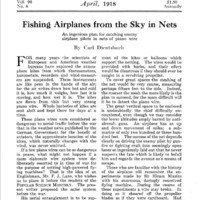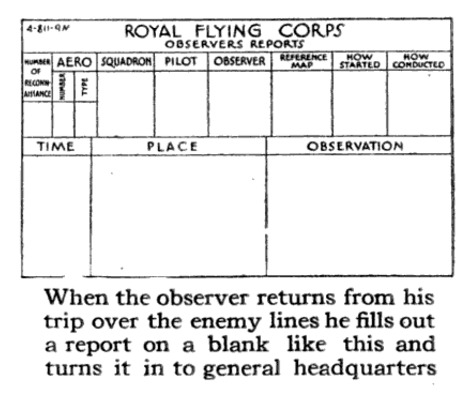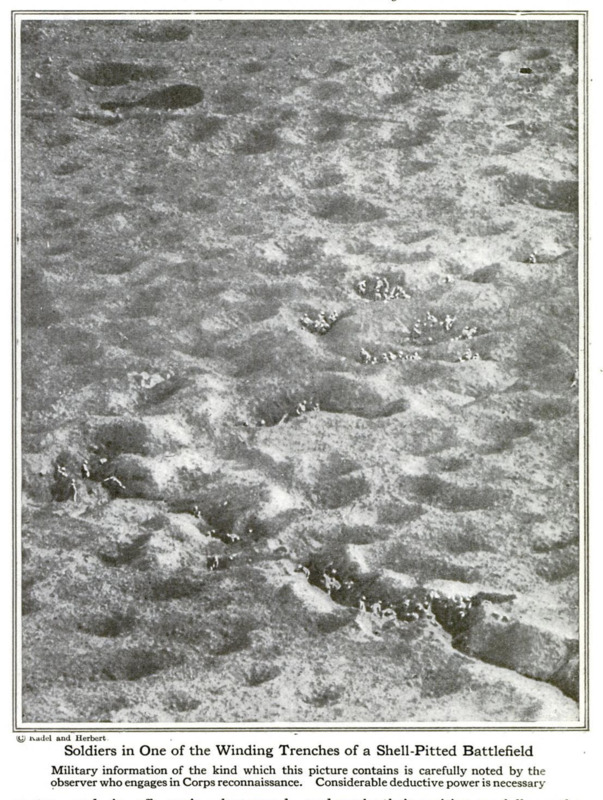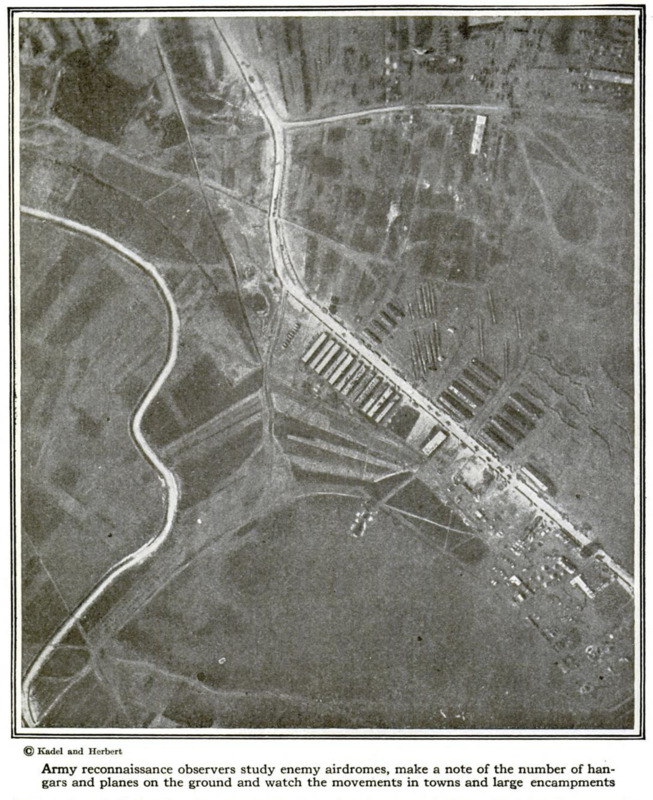-
Title (Dublin Core)
-
Aerial reconnaissance
-
Article Title and/or Image Caption (Dublin Core)
-
The eyes in the air. All aboard for a reconnaissance flight over the German lines
-
Caption 1: Soldiers in one of the winding trenches of a shell-pitted battlefield. Military information of the kind which this picture contains is carefully noted by the observer who engages in Corps reconnaissance. Considerable deductive power is necessary
-
Caption 2: Army reconnaissance observers study enemy airdromes, make a note of the number of hangars and planes on the ground and watch the movements in towns and large encampment
-
extracted text (Extract Text)
-
IN the British Flying Corps there are
two kinds of air reconnaissance work—
Corps and Army. Corps reconnais-
sance is carried out by a single airplane
and army reconnaissance by squadrons of
machines numbering not less than five
and as many as thirty. To understand
just what a Corps reconnaissance flight
means it will be necessary for me to trans-
port you to an active section of the West-
tern battlefront during the summer.
A two-gun, two-seater Sopwith fighter
is trundled out of a hangar. While the
pilot is inspecting the map of the territory
over which he is to fly,
the observer receives
his orders to get infor-
mation on the move-
ment of enemy troops,
motor transports, trains
and the direction in
which they are going,
over an area of not
more than ten thousand
yards in front of the
allied position. A du-
plicate of the pilot's
map and writing ma-
terials are ready in the observer's seat.
As the final order is given, the plane
ascends and wings its way over the lines
towards the enemy. The pilot climbs
rapidly, keeping a wary eye open forenemy
air-raiding squadrons. The usual height
at which he operates is from six thousand
to ten thousand feet.
Nearing the German lines the observer
eagerly scans the ground below through
powerful glasses. If you were to look
through these same glasses you would see
mile after mile of shell-marked earth—
every mile seemingly the same as the
next. But to the observer every foot of
that ground holds information worth
noting, information which he is willing to
givehis life to get. The pilot doesn’t linger
over the battlelines. His work is still to
be done back of the enemy’s trenches.
Far below the plane is a thin wisp of
white smoke. To the uninitiated it
means nothing; but the men in the plane
know that it is a train winding towards
the front. Its position is quickly marked
on the map.
What's That Cloud of Dust?
A white road next occupies their atten-
tion. The pilot drops the plane a little
-utterly oblivious to the anti-aircraft
shells bursting around him. One part of
the road is obscured by a black smudge
and a cloud of dust. A regiment of in-
fantry is on the march. Why infantry
and not cavalry? The dust cloud tells.
It would hang in the |
rear of cavalry and the
men and horses would
look like black specks. |
It is such deductive |
reasoning as this that
an observer has to be
trained to make: |
The observer esti-
mates the number of |
troops by figuring what
space they occupy. A |
little further on, three
black specks move rap- |
idly down the road. Motor trucks in a
hurry. All this is recorded by the watch- |
ful observer who becomes more keen as
the minutes pass.
The plane is over a railroad station now.
Are there any parked motors? How many
cars are on ithe rails? Several work- |
ing parties below run for cover when the
plane hovers over them. Evidently this
is an important depot as seven ‘“‘archies”
hurl shells skyward in an effort to scare
the aerial visitor away. A shell bursts |
near by. The plane rocks from the ex-
plosion. Then, as the pilot shuts off the
motor, the machine dashes earthwardina
nosedive. No! he is not hit. The ob-
server just wants a closer view of the |
depot. Nearer and nearer the plane |
swoops, with machine-guns from the
ground adding to the din from the anti-
aircraft guns. Five hundred feet from
his objective he flattens out, opens up the
motor, and is off again—homeward
bound.
Again the battlelines come into view
below, and the observer looks out for new
trenches. Sure enough he sees several,
and marks their position carefully on the
map; also whether they are traverse or
communication trenches. The condition
of the barbed wire entanglements next
engages his attention. Where they are,
broken by shell fire he sees smudges and
spots, all of which are faithfully recorded.
Camouflage or a Battery—Which?
The shells come thick and fast, but the
pilot is an old hand at the game; he'll
stick till the work is done. Cleverly
hidden on the ground, the observer sees
some small narrow-gage tracks, terminat-
ing in several pits. Has he discovered a
new enemy battery, or is it camouflage?
He must see the gun flashes before being
sure. There they are! One! Two!
Three! Four! Five! He also sees the
blast marks in front of the battery. Now
he is satisfied. Signalling the pilot he
focusses his glasses again—this time in the
direction of home.
A few minutes later, watchers at the
R. F. C. airdrome see the reconnaissance
plane winging its way back home, and
shortly it settles safely to earth outside
the hangar.
The observer fills out his report on a
blank similar to the specimen shown
on page 508 and turns it in to G. H. Q.
(General Headquarters). The filing of
this report marks the conclusion of the
Corps reconnaissance.
Army reconnaissance squadrons carry
cameras and take photographs at many
different points. One of these squadrons
will often fly several hundred miles into
' enemy territory in order to gain desired in-
formation. Instead of writing down single
items as in Corps work, the observers
report the general impression gained from
the entire trip. The reason for this is
that there are sure to be many movements
which are not important, when a large
territory is covered. Army reconnais-
sance observers study enemy airdromes,
make a note of the number of hangars and
planes on the ground and watch the move-
ments in towns and large encampments.
Rivers and canals are also looked for,
particularly if there are any ships on them.
The size and type of boat must be re-
ported; also to which side it is nearer.
What the Observer Looks For in
Army Reconnaissance
The railroads, highways, woods and
towns are studied as in Corps reconnais-
sance, except that an especial look-out is
kept for hostile kite-balloons, “blimps,”
and aircraft. Each squadron is escorted
by scout machines whose duty it is to keep
off attacking planes. The pilot of an
Army reconnaissance plane must not
give offensive battle to the enemy. The
scouts are there for that. Should an
enemy plane get through the formation,
however, it is the observer's duty to see
the enemy first and open fire. If he
doesn’t it probably means that his plane
will “crash,” and not only will he and his
mate go down to death, but the records
for which they risked so much will be
destroyed.
Army reconnaissances are carried out
at from one to twelve thousand feet, and
strict orders are issued that there be no
straggling. A favorite pastime of the
Germans is to send three or more ma-
chines into the air to look for our strag-
glers. Perched high in the sky, generally |
about eighteen thousand feet, these |
hawks watch and wait. Suppose a fight-
ing scout has motor trouble or wants to
look around a little. He swings out of
line and the others close in. Soon the
squadron is almost out of sight, home-
ward bound with the precious reports.
The scout flies along at about fourteen
thousand feet. Then down from their
perch swoop the Germans. The rat-tat-
tat of their machine-guns warns the allied
pilot of his peril. He may down one or
possibly two of his antagonists, but in the
end he crashes to earth the loser in an un-
equal fight. That is why R. F. C. orders
read “Do not straggle; to do so means
the loss of pilot and plane.”
In Corps reconnaissance the pilot does
not run such a risk, as he flies over a com-
paratively small territory and can gen-
erally dash for home if attacked. Of
course he has to contend with anti-air-
craft shells and the possibility of a sur-
prise attack from the air; but for all that |
his lot is easier than that of other pilots
who venture far into enemy territory.
You will be astonished to learn that the |
average age of R. F. C. pilots doing |
reconnaissance work is twenty and of
observers twenty-two. It requires young.
blood and muscle to stand the strain, risk
and excitement of this branch of the air |
service. That results so far have more |
than justified expectations, is a tribute to |
the skill and bravery of these youngsters.
-
Contributor (Dublin Core)
-
Henry Bruno (writer)
-
Language (Dublin Core)
-
eng
-
Date Issued (Dublin Core)
-
1918-04
-
pages (Bibliographic Ontology)
-
508-511
-
Rights (Dublin Core)
-
Public Domain (Google digitized)
-
References (Dublin Core)
-
Canada
-
Archived by (Dublin Core)
-
Filippo Valle
-
Alberto Bordignon (Supervisor)
 Popular Science Monthly, v. 92, n. 4, 1918
Popular Science Monthly, v. 92, n. 4, 1918







